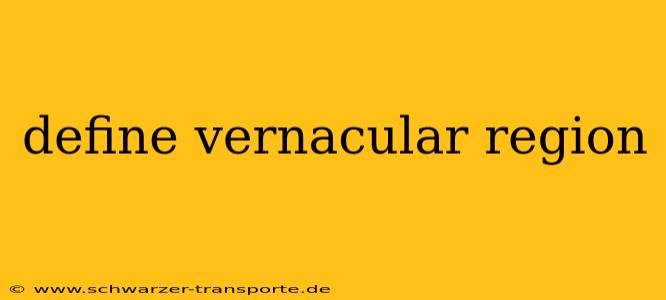Vernacular regions, unlike formal or functional regions, aren't defined by strict boundaries or administrative lines. Instead, they're shaped by shared cultural traits, beliefs, and practices. Understanding vernacular regions offers a fascinating glimpse into the intricate tapestry of human geography. This article delves into the definition, characteristics, and examples of vernacular regions.
What is a Vernacular Region?
A vernacular region, also known as a perceptual region, is a region defined by the shared perceptions and feelings of the people who live in it. These regions are subjective and based on cultural identity, rather than objective criteria like political boundaries or economic activities. Think of it as a place where people share a sense of belonging and identify themselves with a particular area based on shared cultural attributes.
Characteristics of Vernacular Regions
Several key characteristics define vernacular regions:
- Subjective Boundaries: The borders of a vernacular region are fluid and indistinct. They're based on people's perceptions and may vary depending on who you ask. There's no official map or declaration.
- Shared Cultural Traits: These regions are unified by common cultural elements. This could include dialect, cuisine, religious beliefs, architectural styles, recreational activities, or even shared historical experiences.
- Sense of Place: People who live in a vernacular region often develop a strong sense of place and belonging. This connection to the land and its culture shapes their identity.
- Informal Definition: Vernacular regions aren't officially recognized by governments or organizations. They exist in the minds of the people who inhabit and identify with them.
- Dynamic Nature: The boundaries and characteristics of vernacular regions can shift and change over time as cultures evolve and interact.
How Vernacular Regions Differ from Other Types of Regions
It's important to distinguish vernacular regions from other types of regions:
- Formal Regions: These are defined by a shared characteristic, like a climate type or a political boundary. Examples include the Sahara Desert (climate) or France (political). The boundaries are clearly defined.
- Functional Regions: These are organized around a central node or point, like a transportation hub or a market area. Examples include a metropolitan area or the service area of a television station. Function dictates the boundary.
Examples of Vernacular Regions
The concept of a vernacular region becomes clearer with examples:
- The South (USA): This is a widely recognized vernacular region characterized by specific cultural traits, including a distinct dialect, barbecue traditions, and a history tied to the Civil War. The boundaries are blurry, however; some might consider parts of Virginia "Southern," while others might not.
- The Midwest (USA): Similar to "The South," the Midwest is perceived differently by varying groups. Its defining features might include agricultural practices, a sense of community, or specific architectural styles.
- Dixie: This term, often associated with the American South, represents a more culturally specific and potentially contested vernacular region than "The South." Its definition and boundaries vary greatly depending on individual perceptions.
- Silicon Valley (California): While it has some functional aspects, Silicon Valley is also a vernacular region, defined by its association with technological innovation and a particular entrepreneurial culture.
- The Bible Belt (USA): This region is recognized for its strong religious traditions and the importance of evangelical Christianity in the lives of its residents.
Defining Vernacular Regions Through Research
Researchers use various methods to study vernacular regions:
- Surveys and Interviews: Gathering people's perceptions of their region helps define its boundaries and characteristics.
- Mapping: Creating maps based on survey data or other indicators of cultural traits visually represents the region.
- Statistical Analysis: Analyzing data on cultural practices, demographics, and other relevant factors helps confirm perceived regional characteristics.
Conclusion
Vernacular regions are valuable tools for understanding cultural landscapes. They show how shared perceptions and cultural traits shape people's identities and sense of place. While their boundaries are subjective and fluid, their significance in understanding human geography remains undeniable. The ongoing evolution of culture means that the study of vernacular regions remains a dynamic and important field of geographical research.
